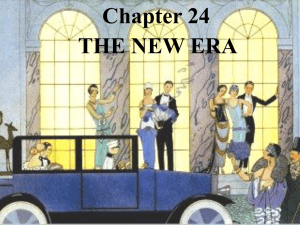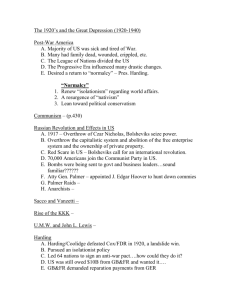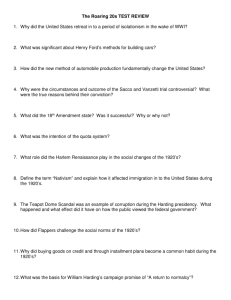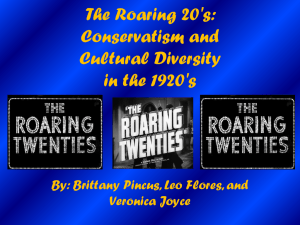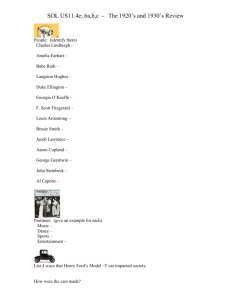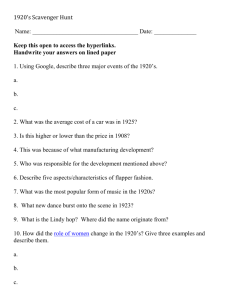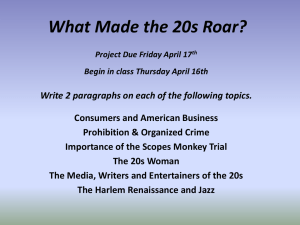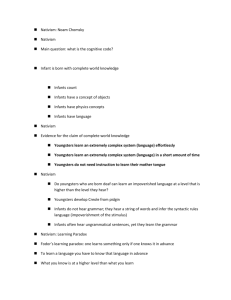File - United States History
advertisement
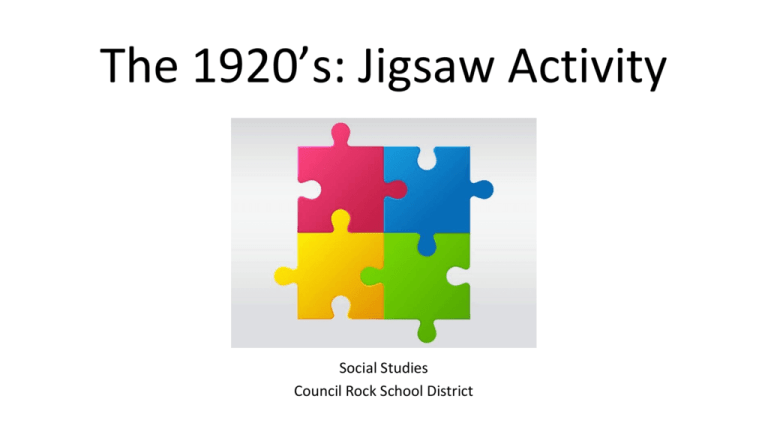
The 1920’s: Jigsaw Activity Social Studies Council Rock School District Jigsaw Directions “Home Group” –Group that you will start and end with today and where you will learn from other content “masters” “Master Group” –Where you will work together to master a specific content area -Directions1. Put students into home groups 2. Assign content areas for master groups (You may need more than 1) 3. Change into master groups to “master” your content area 4.Go back to home groups to teach/learn Jigsaw Topics: 1. 2. 3. 4. Politics of the 1920’s (Pgs. 208-211) A Growing Economy (Pgs. 212-216) Nativism (Pgs. 217-220) Cultural Innovations (Pgs. 221-223) Master Group Directions/Suggestions: • • • • 1. Divide the work among group members 2. Define/identify terms FIRST 3. Take your time, there is a lot of writing 4. Do not worry about review questions until tomorrow Only Rule: • A student can NOT take your notes and copy them, you must read your notes to other group members. Topic 1: Politics of the 1920’s: • Define/Identify/Summarize: – – – – – – The Teapot Dome Scandal Isolationism The Dawes Plan The Washington Conference Kellogg-Briand Pact London Naval Treaties Answer Lesson 1 Review Questions on page 211: #’s 1-4 1. What were some ways in which the United States showed signs of isolationism after World War 1? 1. Not joining the League of Nations 2. Not signing the Treaty of Versailles 2. Name one important way in which the Harding and Coolidge administrations were alike in terms of political appointments. • President Harding appointed good people such as, Charles Evans Hughes (Secretary of State), Herbert Hoover (Secretary of Commerce), and Andrew Mellon as Secretary of the treasury. • President Coolidge kept these three influential leaders in his cabinet 3. How was Harding’s effort to return to “normalcy” prevented by political scandals? • These scandals were caused by officials who were given their positions because of their personal ties to the President. 4. What government policies helped the economy recover from postwar recession? • The government cut taxes so people would have more disposable income and spend money. • Also sought to balance government regulations of business by encouraging businesses to form trade unions. Topic 2: A Growing Economy: • Define/Identify/Summarize: – – – – – – – Mass Production The Assembly Line and the Model T The Airline Industry Radio Consumer Credit Mass Advertising The Farm Crisis Answer Lesson 2 Review Questions on page 216: #’s 1,3,4, & 5 1. How did the assembly line help makes car affordable for more Americans? • The assembly line divided operations into simple tasks with minimal motions so workers could make more cars in less time. • These savings in manufacturing costs were passed on to the consumer in the form of lower prices, which made automobiles affordable to more people. Model T 3. How did new industries change the lives of Americans in the 1920’s? • The automobile eased isolation and let people commute to work from farther away than before. • Airlines sped up mail delivery and introduced a fast way to travel thousands of miles. • The audio industry brought breaking news and entertainment into people’s daily lives and homes. 4. How did attitudes toward credit and consumerism change in the 1920’s? • People were no longer afraid of getting into debt. • They started buying more items on credit. • Some people bought more than they could afford to pay back. 5. Why did farmers miss out on the prosperity of the 1920’s? • They had invested in tools and technologies to increase their output so they could meet the high demands for food in European countries during WWI. • After the war, European demand decreased dramatically, leading to lower prices. Topic 3: Nativism: • Define/Identify/Summarize: – – – – – – – Nativism The Sacco-Vanzetti Case Return of the KKK National Origins Act Changes for Women Religious Fundamentalism Prohibition and Speakeasies Answer Lesson 3 Review Questions on page 220: #’s 1-4 1. Why were Sacco and Vanzetti considered anarchists and how did that affect the result of their trial? • Sacco and Vanzetti opposed all forms of government, • Since they were immigrants, they were assumed guilty of murder, and sentenced to death. Trial Clip 2. Make a case for the connection between the causes of nativism and the rise of the KKK. • The rise of immigration, job competition, fear of losing jobs, and economic recession contributed to nativism and the belief that immigrants, African Americans, and other minorities were “un-American.” 3. Why did nativism strengthen during the 20’s, and how did the government deal with the tensions? • An economic recession made people fearful of losing their jobs to the increased number of immigrants. • Many people were still prejudice against Germans and Communists because of WWI, and this prejudice grew to include all foreigners. • The government responded with more restrictive immigration policies, such as the Emergency Quota Act and the National Origins Act. 4. Why do you think some Americans feared the “new morality?” • The “New morality” glorified youth and personal freedom, and brought big changes, particularly to the status of women. • Some Americans thought that if this “new morality” became standard, traditional “acceptable” behaviors and values would come to an end. • Key terms: Flappers and speakeasies. Flappers Topic 4: Cultural Innovations: • Define/Identify/Summarize: – – – – – – Bohemian Modern American Art Major Poets and Writers Movies and Radio Shows Mass Media Sports Answer Lesson 4 Review Questions on page 223: #’s 1-4 1. How is today’s media similar to that of the 20’s? • Mass media still provided information and entertainment to a broad audience. 2. Why do you think the art and literature of the 20’s had a such diverse range of styles? • Artists, writers, and thinkers were freed from past traditions and expectations. • They could develop personal individualistic styles based on only their own experiences, visions, and talents. 3. How did many artists and writers of the time describe the 20’s? • Many saw it as expressive and modern. • Others described it in negative terms as an ear of delusion, emptiness, and isolation. 4. Why did many Americans have more time for entertainment, and did they spend their time? • The economic prosperity of technological innovations of the ear gave people more money and more leisure time. • They spent time listening to radio broadcasts of music comedy, and sports events, and going to movies. • They also followed sports such as baseball and boxing.
